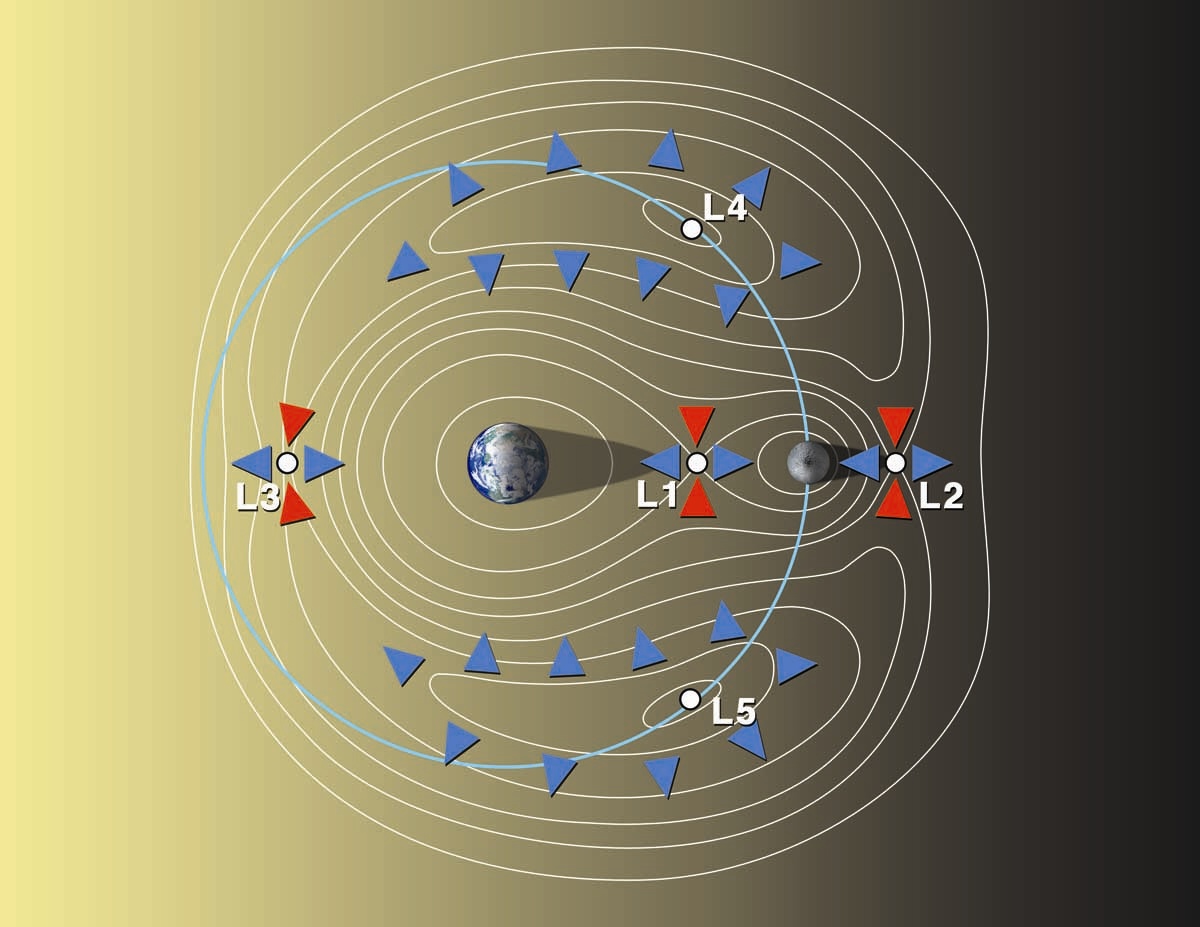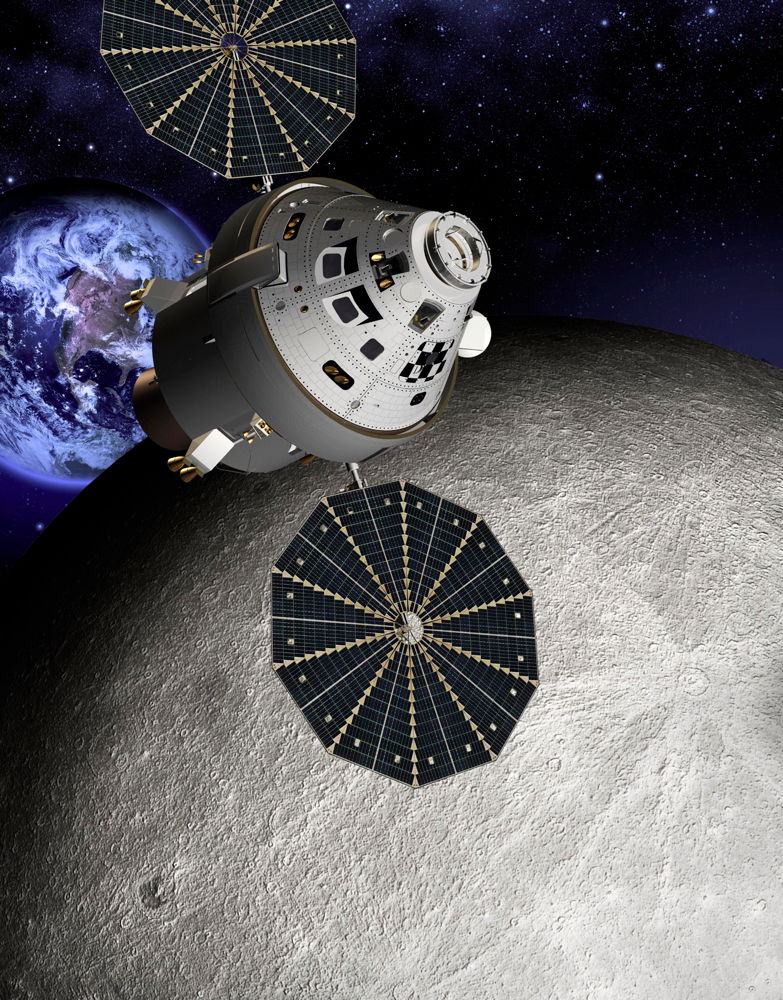NASA Mulls Deep-Space Station on Moon's Far Side

There appears to be support within NASA to position astronauts at an Earth-moon libration point to bolster the space agency’s plans of pushing beyond low-Earth orbit with its Orion spacecraft design.
Anchoring hardware and a crew at the Earth-moon L2 "gateway" would offer many benefits, advocates say. One of them is building on multinational cooperation honed at the International Space Station (ISS).
Under review is use of Russian-supplied hardware at the L2 point, according to insiders contacted by SPACE.com. Surplus space shuttle gear and ISS-flight-ready spares are also in the mix.
Regarding the use of Russian space hardware, both the Multipurpose Laboratory Module and the Scientific-Power Module are new modules being developed in Russia. Both will add new capabilities to the ISS. A proposal on the table seeks to use a similar Russian-provided Scientific-Power Module in cislunar space as a base of operations for exploration missions. [Gallery: Visions of Deep-Space Station Missions]
NASA space planners have been sketching out an exploration strategy that would make use of the Lagrange points. For one, by exploring and working beyond the Earth’s radiation belts, more can be learned about space radiation protection. Additionally, the Lagrange points provide unique perspectives of the moon, sun and Earth. Sojourns to the Earth-moon L2 would take humans farther than they have ever been from Earth.
Done deal?
A recent Orlando Sentinel newspaper story kick-started the perception that NASA officials have picked a leading candidate for the agency’s next major mission: creation of a "gateway spacecraft" parked at the Earth-moon libration point 2, also known as EML-2.
Breaking space news, the latest updates on rocket launches, skywatching events and more!
Indeed, NASA has spotlighted the fact that, as crewed missions extend farther from Earth and for longer periods of time, they will require new capabilities to enable safe and sustainable habitation and exploration.
As reported by SPACE.com earlier this year, a Feb. 3 memo from William Gerstenmaier, NASA’s associate administrator for human exploration and operations, noted that a team would be formed to develop a cohesive plan for exploring the EML-2 spot in space.
Libration points, also known as Lagrangian points, are places in space where the combined gravitational pull of two large masses roughly balance each other out, allowing spacecraft to essentially "park" there.
But whether a true decision has been made, or NASA is floating a trial balloon, is unclear. Space agency balloons have been burst before. [Giant Leaps: Top Milestones of Human Spaceflight]
Many options…many routes
According to a statement issued Sept. 24 by NASA’s Office of Communications, the official agency response to the news story regarding the prospect of a deep-space station is:
"NASA is executing President Obama’s ambitious space exploration plan that includes missions around the moon, to asteroids, and ultimately putting humans on Mars," the statement explains. "There are many options — and many routes — being discussed on our way to the Red Planet. In addition to the moon and an asteroid, other options may be considered as we look for ways to buy down risk — and make it easier — to get to Mars."
The NASA statement explains that the space agency has "regular meetings" with the Office of Management and Budget, the White House science office, Congress and other stakeholders "to keep them apprised of our progress on our deep space exploration destinations."
NASA sources contacted by SPACE.com do sense, however that the new NASA objective could go public not long after the Nov. 6 presidential election.
Pleasant surprise
"In the advancement of human spaceflight, missions to the Earth-moon Lagrange points are a great idea," said Dan Lester, in the department of astronomy at the University of Texas in Austin.
"It would be a pleasant surprise if the plan was for not just a visit, but for a habitat there. The easiest option would be just to send people to those locations on multiple Orion flights…visit and come back. Committing to a habitat there is a bigger deal."
Lester told SPACE.com that there are big policy advantages to a deep-space habitat.
"Such a habitat builds clearly on the legacy of ISS — both the habitation technology and the potential for international partnerships. Doing something that clearly links back to our huge investment in ISS looks smart. Just sending multiple Orions to L1 or L2 doesn’t do that," he said. [Gallery: NASA's Orion Capsule for Deep Space Missions]
Attractive destination
Early missions to Earth-moon L2 can support robotic operations on the far side of the moon, to explore unique geological features like the enormous and ancient South Pole-Aitken Basin, or to deploy radio telescopes in the quiet zone, said Josh Hopkins, a space exploration architect for Lockheed Martin Space Systems Co. in Denver.
Lockheed Martin is builder of NASA’s Orion spacecraft.
"There have been no landings on the far side of the moon by either Apollo astronauts or robotic spacecraft," Hopkins told SPACE.com.
Hopkins said that the Earth-moon L2 region is an attractive destination for international collaboration in part because it is one of the easiest locations to reach beyond low-Earth orbit — easier than geosynchronous orbit, L1, or lunar orbit.
"That means that the U.S. can collaborate with countries which might not be able to afford to participate in a more difficult objective during this time of austerity," Hopkins said.
Game changer
Uplifted by the chatter about an L2 deep-space station is Jack Burns, director of the Lunar University Network for Astrophysics Research (LUNAR) Center at the University of Colorado, Boulder. LUNAR is funded by the NASA Lunar Science Institute.
Burns has been leading a look, along with a team that includes Lockheed Martin space planners, at a lunar L2-far side exploration and science mission concept using Orion and a teleoperated lander/rover.
"This first step back into interplanetary space…it’s the lowest risk because you’re talking about mission durations of one to two months and only a few days to get back to Earth," Burns told SPACE.com.
"There’s no reason why we can’t do this mission later in the decade," Burns said, calling the Earth-moon L2 gateway idea a "game changer."
Such an endeavor, Burns said, would serve as a first step beyond low-Earth orbit and prove out operational spaceflight capabilities such as life support, communication, high speed re-entry and radiation protection before more difficult human exploration missions.
Telerobotics training
Added to a shakeout of Orion and other hardware emplaced in deep space, there’s exciting science to be done via teleoperation of robots on the moon, Burns said. The astronaut crew would control landers and rovers on the unexplored lunar far side, he said, which would obtain samples from that geologically appealing spot and position a low-radio-frequency telescope there.
Burns said that such telerobotic oversight would also demonstrate capability for human and robotic cooperation on future — and more complex — deep-space missions, such as exploring Mars.
Supported by the NASA Office of the Chief Technologist, Burns is working with the space agency's Ames Research Center to use a rover to simulate deployment of polyimide film antennas as they would be deployed on the lunar surface.
This test would also make use of astronauts onboard the International Space Station to teleoperate that rover to unroll antennas via control from space.
At the moon, Burns said — and done by astronauts at the Earth-moon L2 locale — the polyimide film would be unrolled to deploy the antennas. The antennas deployed on the far side would then be electronically phased to produce a sensitive radio interferometer for tracking down the "Cosmic Dawn."
"That’s the game changer. We’ve got this really exciting science component," Burns said. "It’s affordable…we can do this all within NASA’s current budget, and this step one allows us to begin a new epoch of human-robotic exploration."
Leonard David has been reporting on the space industry for more than five decades. He is a winner of last year's National Space Club Press Award, a past editor-in-chief of the National Space Society's Ad Astra and Space World magazines, and has written for SPACE.com since 1999. Follow SPACE.com on Twitter @Spacedotcom. We're also on Facebook & Google+.

Leonard David is an award-winning space journalist who has been reporting on space activities for more than 50 years. Currently writing as Space.com's Space Insider Columnist among his other projects, Leonard has authored numerous books on space exploration, Mars missions and more, with his latest being "Moon Rush: The New Space Race" published in 2019 by National Geographic. He also wrote "Mars: Our Future on the Red Planet" released in 2016 by National Geographic. Leonard has served as a correspondent for SpaceNews, Scientific American and Aerospace America for the AIAA. He has received many awards, including the first Ordway Award for Sustained Excellence in Spaceflight History in 2015 at the AAS Wernher von Braun Memorial Symposium. You can find out Leonard's latest project at his website and on Twitter.




